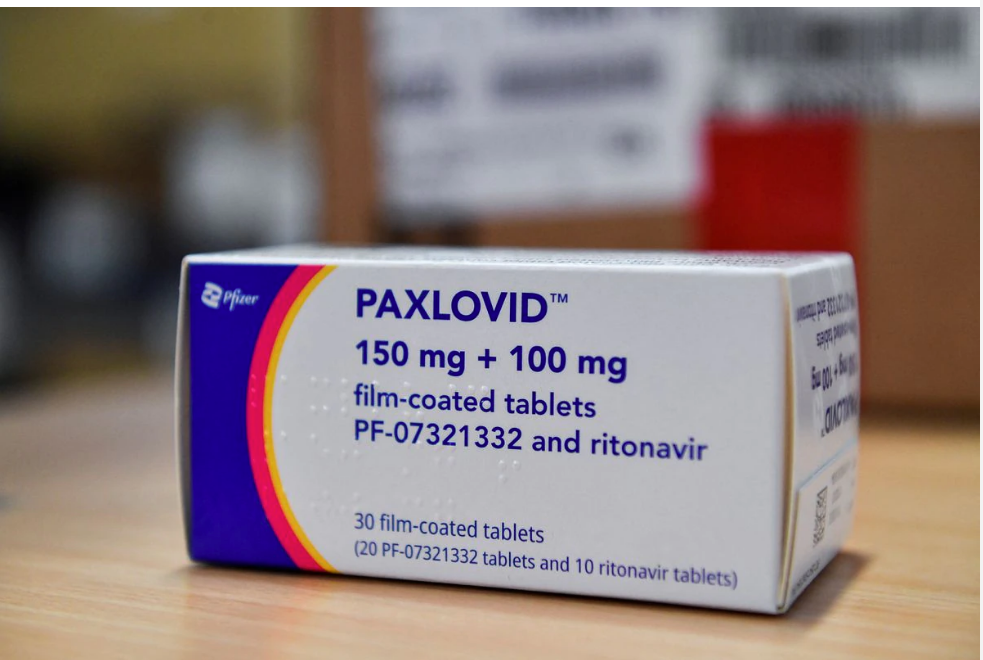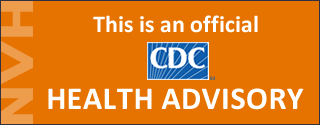COVID-19 Rebound After Paxlovid Treatment
Distributed via the CDC Health Alert Network
May 24, 2022, 9:00 AM ET
CDCHAN-00467
Summary
The Centers for Disease Control and Prevention (CDC) is issuing this Health Alert Network (HAN) Health Advisory to update healthcare providers, public health departments, and the public on the potential for recurrence of COVID-19 or “COVID-19 rebound.” Paxlovid continues to be recommended for early-stage treatment of mild to moderate COVID-19 among persons at high risk for progression to severe disease. Paxlovid treatment helps prevent hospitalization and death due to COVID-19. COVID-19 rebound has been reported to occur between 2 and 8 days after initial recovery and is characterized by a recurrence of COVID-19 symptoms or a new positive viral test after having tested negative. A brief return of symptoms may be part of the natural history of SARS-CoV-2 (the virus that causes COVID-19) infection in some persons, independent of treatment with Paxlovid and regardless of vaccination status. Limited information currently available from case reports suggests that persons treated with Paxlovid who experience COVID-19 rebound have had mild illness; there are no reports of severe disease. There is currently no evidence that additional treatment is needed with Paxlovid or other anti-SARS-CoV-2 therapies in cases where COVID-19 rebound is suspected.
Regardless of whether the patient has been treated with an antiviral agent, risk of transmission during COVID-19 rebound can be managed by following CDC’s guidance on isolation, including taking other precautions such as masking.
Staying up to date with COVID-19 vaccination lowers the risk of getting COVID-19 and helps prevent serious outcomes of COVID-19, such as severe illness, hospitalization, and death.
Background
Paxlovid (nirmatrelvir tablets; ritonavir tablets) is a prescription oral antiviral drug that reduces the risk of hospitalization and death for patients with mild-to-moderate COVID-19 who are at risk of disease progression and severe illness (1). It is available under Emergency Use Authorization (EUA) by the U.S. Food and Drug Administration (FDA) for adults and pediatric patients (12 years of age and older weighing at least 40 kilograms or 88 pounds). Treatment should be initiated as soon as possible and within 5 days of symptom onset among persons eligible to receive the treatment under the EUA who:
- Test positive for SARS-CoV-2 infection;
- Have mild to moderate illnessexternal icon;
- Have one or more risk factors for progression to severe disease;
- Do not require hospitalization due to severe or critical COVID-19 at the time of treatment initiation; and
- Do not have evidence of severe renal or hepatic impairment.
Recent case reports document that some patients with normal immune response who have completed a 5-day course of Paxlovid for laboratory-confirmed infection and have recovered can experience recurrent illness 2 to 8 days later, including patients who have been vaccinated and/or boosted (were up to date with COVID-19 vaccination) (2-4). These cases of COVID-19 rebound had negative test results after Paxlovid treatment and had subsequent positive viral antigen and/or reverse transcriptase polymerase chain reaction (RT-PCR) testing. Both the recurrence of illness and positive test results improved or resolved (median of 3 days) without additional anti-COVID-19 treatment. Based on information from the case reports, COVID-19 rebound did not represent reinfection with SARS-CoV-2 or the development of resistance to Paxlovid; also, no other respiratory pathogens were identified among known cases. Possible transmission of infection during COVID-19 rebound has been described (3); however, it remains unknown whether the likelihood of transmission during rebound differs from the likelihood of transmission during the initial infection.
In the Paxlovid clinical trial, a small number of participants had one or more positive SARS-CoV-2 RT-PCR test results after testing negative, or an increase in the amount of SARS-CoV-2 detected by PCR, after completing their treatment course (5). This finding was observed in persons administered Paxlovid and in persons given placebo. There was no increased occurrence of hospitalization or death, and there was no evidence that the rebound in detectable viral RNA was the result of SARS-CoV-2 resistance to Paxlovid (5).
COVID-19 rebound is characterized by a recurrence of symptoms or a new positive viral test after having tested negative. People with COVID-19 rebound should follow CDC recommendations regarding isolation of infected patients regardless of treatment with an antiviral agent and/or previous isolation after the initial infection. People with recurrence of COVID-19 symptoms or a new positive viral test after having tested negative should restart isolation and isolate again for at least 5 days. Per CDC guidance, they can end their re-isolation period after 5 full days if fever has resolved for 24 hours (without the use of fever-reducing medication) and symptoms are improving. The individual should wear a mask for a total of 10 days after rebound symptoms started. Some people continue to test positive after day 10 but are considerably less likely to shed infectious virus. Currently, there are no reports of severe disease among persons with COVID-19 rebound. Paxlovid continues to be recommended for early-stage treatment of mild to moderate COVID-19 among persons at high risk for progression to severe disease.
Recommendations for Healthcare Providers
For patients with COVID-19 rebound
- There is currently no evidence that additional treatment for COVID-19 is needed for COVID-19 rebound. Based on data available at this time, patient monitoring continues to be the most appropriate management for patients with recurrence of symptoms after completion of a treatment course of Paxlovid.
- Advise people with COVID-19 rebound to follow CDC’s guidance on isolation and take precautions to prevent further transmission. Patients should re-isolate for at least 5 days. Per CDC guidance, they can end their re-isolation period after 5 full days if fever has resolved for 24 hours (without the use of fever-reducing medication) and symptoms are improving. The patient should wear a mask for a total of 10 days after rebound symptoms started.
- Consider clinical evaluation of patients who have COVID-19 rebound and symptoms that persist or worsen.
- Healthcare providers are encouraged to report cases of COVID-19 rebound to Pfizer after Paxlovid treatment using the following online tool: Pfizer Safety Reportingexternal icon and to FDA MedWatch. Complete and submit a MedWatch formexternal icon, or complete and submit FDA Form 3500 (health professional) by fax (1-800-FDA-0178). Call 1-800-FDA-1088 for questions.
For patients just diagnosed with COVID-19
- Healthcare providers should counsel patients on available COVID-19 treatment options, particularly for those patients at increased risk of developing severe COVID-19.
- Paxlovid should be considered for any patient who meets the eligibility criteria. For information on Paxlovid eligibility, refer to FDA’s Fact Sheet for Healthcare Providersexternal icon.
- Due to the potential for severe drug-drug interactions with the ritonavir component of Paxlovid, it is strongly suggested that healthcare providers not experienced in prescribing this drug refer to the Fact Sheet for Healthcare Providersexternal icon, the Paxlovid Patient Eligibility Screening Checklist Tool for Prescribersexternal icon, and the NIH Statement on Paxlovid Drug-Drug Interactions | COVID-19 Treatment Guidelinesexternal icon. Healthcare providers can also contact a local clinical pharmacist or infectious disease specialist for advice.
- For further information on the use of Paxlovid, CDC recommends healthcare providers continue to closely follow NIH’s COVID-19 Treatment Guidelinesexternal icon, the Assistant Secretary for Preparedness and Response Public Health Emergency COVID-19 Therapeutics siteexternal icon, and IDSA’s Guidelines on the Management of Patients with COVID-19external icon.
Recommendations for Public Health Departments and Public Health Jurisdictions
- State and local health departments should be aware of COVID-19 rebound and disseminate the recommendations for healthcare providers and the public.
- Health departments should communicate to individuals about measures to prevent further transmission. The phenomenon of COVID-19 rebound reiterates the importance of following CDC’s isolation guidance. Isolation should be restarted after the onset of rebound symptoms or a positive test result. Per CDC guidance, people can end re-isolation after 5 full days with resolution of their fever for 24 hours (without the use of fever-reducing medication) and if their symptoms are improving. The individual should wear a mask for a total of 10 days after rebound symptoms started.
- Health departments should communicate ongoing and up to date information on therapeutics for COVID-19 and their availability to healthcare providers within their jurisdiction.
Recommendations for the Public
- You may be experiencing COVID-19 rebound if you have been diagnosed in the past 2 weeks and have recovered from COVID-19 and then experience recurrent COVID-19 symptoms or develop newly positive test results after recovery.
- If you experience COVID-19 rebound, you should follow CDC’s isolation guidance. Isolate again and restart the recommended 5-day isolation period at the time of recurrence of symptoms or a new positive COVID-19 test result. You can end re-isolation after 5 days if you are fever-free for 24 hours without the use of fever-reducing medication and your symptoms are improving. You should also wear a mask for 10 days after rebound.
- Contact a healthcare provider if your COVID-19 rebound symptoms persist or worsen.
- Consult with your healthcare provider if you have additional questions about your treatment.
- You are encouraged to report a possible case of COVID-19 rebound after Paxlovid treatment to Pfizer using the following online tool: Pfizer Safety Reportingexternal icon.
For More Information
- FDA Updates on Paxlovid for Health Care Providers | FDAexternal icon
- Paxlovid Patient Eligibility Screening Checklist Toolexternal icon
- FDA Paxlovid Emergency Use Authorization letterexternal icon
- COVID-19 Treatment Guidelines: What’s Newexternal icon
- COVID-19 Treatment Guidelines: Antiviral Therapyexternal icon
- NIH Statement on Therapies for High-Risk, Nonhospitalized Patients | COVID-19 Treatment Guidelinesexternal icon
- NIH Statement on Paxlovid Drug-Drug Interactions | COVID-19 Treatment Guidelines external icon
- Pfizer Safety Reportingexternal icon
References
- Hammond J, Leister-Tebbe H, Gardner A, Abreu P, Bao W, Wisemandle W, et al. Oral Nirmatrelvir for High-Risk, Nonhospitalized Adults with COVID-19. New Engl J Med 2022; 386(15): 1397-1408.
- Gupta K, Strymish J, Stack G, Charness M. Rapid relapse of symptomatic omicron SARS CoV-2 infection following early suppression with nirmatrelvir/ritonavir. 26 April 2022, PREPRINT (Version 1) available at Research Square [https://doi.org/10.21203/rs.3.rs-1588371/v1].
- Charness M, Gupta K, Stack G, Strymish J, Adams E, Lindy D, Mohi H, Ho D. Rapid relapse of symptomatic omicron SARS CoV-2 infection following early suppression with nirmatrelvir/ritonavir. 13 May 2022, PREPRINT (Version 2) available at Research Square [https://doi.org/10.21203/rs.3.rs-1588371/v2].
- Carlin AF, Clark AE, Chaillon A, Garretson AF, Bray W, Porrachi M, et al. Virologic and Immunologic Characterization of COVID-19 Recrudescence after Nirmatrelvir/Ritonavir Treatment. 18 May 2022, PREPRINT (Version 1) available at Research Square [https://doi.org/10.21203/rs.3.rs-1662783/v1].
- Food and Drug Administration. FDA Updates on Paxlovid for Health Care Providers. Available at: https://www.fda.gov/drugs/news-events-human-drugs/fda-updates-paxlovid-health-care-providersexternal icon. Accessed on May 12, 2022.
The Centers for Disease Control and Prevention (CDC) protects people’s health and safety by preventing and controlling diseases and injuries; enhances health decisions by providing credible information on critical health issues; and promotes healthy living through strong partnerships with local, national and international organizations.






